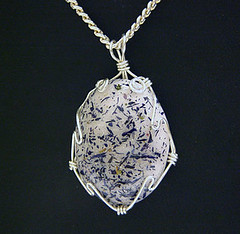The Sutton Slice is an interesting polymer clay technique, where soft bits of clay are pushed into the recesses of a deeply etched rubber stamp, until all the recessed areas are filled to the rim with clay. A sheet of clay is pressed onto the stamp to adhere the sheet to the clay pressed into the recesses, and when the stamp is peeled away from the clay sheet, the recessed areas now become raised areas on the sheet of clay.
Lisa Pavelka’s video on how to do the Sutton Slice shows her method for doing the technique, and I recommend viewing the video a couple of times, just so you can see some of the nuances of doing it. She also has a step-by-step tutorial on HGTV.com, but of the two I prefer the video, both for it’s clarity and for the way the rubber stamp is peeled off the clay – in my opinion, this method works the best.
My local polymer clay guild met this past Saturday, and we all worked on projects with the Sutton Slice. Here are some highlights:
 Ann creates and sells hand-felted mug warmers. She attaches handmade buttons to the felt, and says her customers love that little detail. Here are some Sutton Slice buttons she made at the guild meeting.
Ann creates and sells hand-felted mug warmers. She attaches handmade buttons to the felt, and says her customers love that little detail. Here are some Sutton Slice buttons she made at the guild meeting.
 Pam made an assortment of jewelry pieces with the Sutton Slice technique. I really like the one in the middle; she was using a faux abalone mokume gane cane (if you don’t know what that is, it’s a stack of layered sheets of clay that are very translucent, interspersed with sheets of metallic foil. You can see a good tutorial on this technique in Carol Blackburn’s book, “Making Polymer Clay Beads“.)
Pam made an assortment of jewelry pieces with the Sutton Slice technique. I really like the one in the middle; she was using a faux abalone mokume gane cane (if you don’t know what that is, it’s a stack of layered sheets of clay that are very translucent, interspersed with sheets of metallic foil. You can see a good tutorial on this technique in Carol Blackburn’s book, “Making Polymer Clay Beads“.)
 Silly me, I didn’t want to show these pieces until I was completely done with them. But that was just my pride talking, so posting this picture is somewhat humbling. I’ll try to explain what these things are, because they do look confusing, don’t they!
Silly me, I didn’t want to show these pieces until I was completely done with them. But that was just my pride talking, so posting this picture is somewhat humbling. I’ll try to explain what these things are, because they do look confusing, don’t they!
Starting with the round ones: those are going to be buttons on a blouse I’m planning to make. They match the half-circles, which will be earrings. And yes, they look just like giraffe print!
Which wasn’t on purpose, at all (don’t ya just love happy accidents?). I was playing with a Texture Gallery rubber stamp I’d gotten at Hobby Lobby. I filled the stamp with dark brown clay, then used a light sandy color for the “background” behind the raised “spots”. Looks totally realistic on the randomness of a giraffe print, and I was really excited with the result.
The teardrop shapes are going to be earrings – with the rounded part at the bottom of the earring and the pointed part at the top. I used a “bubbles” unmounted rubber stamp for these, making one pair black and white for my daughter (shhhh… don’t tell Margo! It’s a surprise), and the purple and white pair for myself.
All of these pieces will be getting a very thin clay border around the edge, so that I can fill the recessed areas with resin. It will create an interesting effect – clear, glossy, dimensional recessions with matte, textured raised areas. I hope I like these when they’re done – and of course, I’ll share pictures.



















